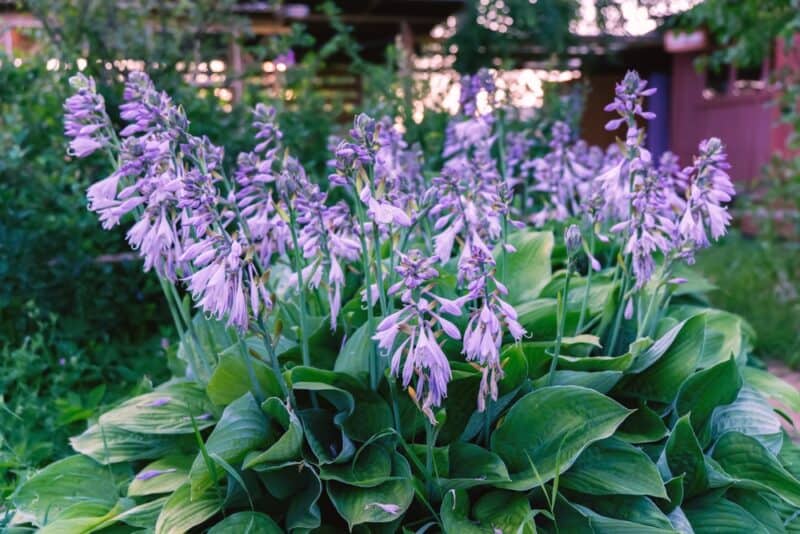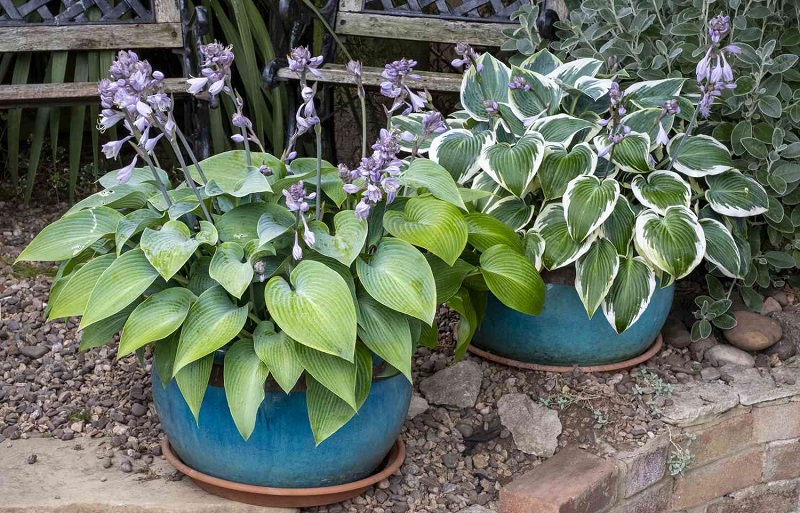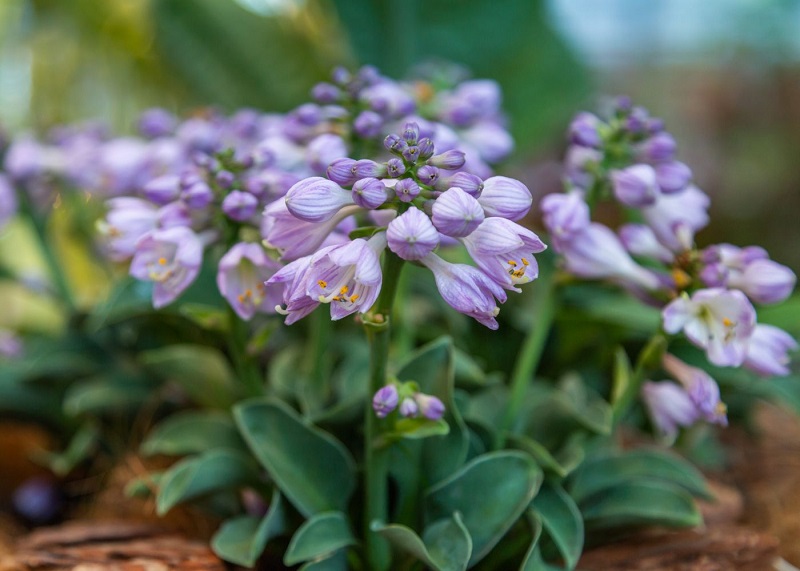Embarking on a journey into the enchanting world of Hostas, one can’t help but wonder: When Do Hostas Bloom? This question, often whispered among gardening enthusiasts, is the key to unlocking the secrets of these verdant treasures. In this comprehensive guide, Gina Farm delves into the intricacies of Hostas blooming, unraveling the mysteries that surround their vibrant blossoms.
Do Hostas Plants Have Flowers?
Yes, Hostas plants do produce flowers. While Hostas are primarily known for their attractive foliage, they also send up flower spikes in the spring or early summer, depending on the specific variety and local growing conditions.
The flowers of Hostas plants typically appear on tall, slender stems that rise above the foliage. The blooms are often tubular or bell-shaped and can be white, lavender, or shades of purple, depending on the variety. The flowers are usually not the primary ornamental feature of Hostas, but they can add a nice touch to the overall appearance of the plant.
It’s worth noting that not all Hostas varieties bloom and some gardeners may choose to remove the flower spikes to direct the plant’s energy into foliage development. The main appeal of Hostas lies in their diverse foliage colors, textures and shapes. If you’re interested in the flowers, there are specific Hostas varieties bred for their attractive blooms and you can select those to enhance the flowering aspect of your garden.

When Do Hostas Bloom?
Hostas are known for their attractive foliage rather than their flowers, but they do produce blooms. The timing of Hostas blooms depends on the specific variety and local growing conditions. In general, Hostas bloom in late spring to early summer.
The majority of Hostas plants send up flower spikes in late spring or early summer, typically from late May to early July, depending on the climate and the specific variety. The flowers are often tubular or bell-shaped and can be white, lavender, or shades of purple. Hostas blooms are usually held on tall, slender stems above the foliage.
It’s important to note that not all Hostas bloom and some gardeners actually remove the flower stalks to encourage the plant to put more energy into foliage development. If you’re growing Hostas for their flowers, it’s a good idea to choose varieties that are known for their attractive blooms.
Keep in mind that the timing of flowering can be influenced by factors such as the specific Hostas variety, local climate and growing conditions. Additionally, some Hostas are bred for late-season or even fall blooming, so it’s a good idea to check the information provided by the plant’s breeder or seller for specific details about the blooming characteristics of a particular Hostas variety.

While factors like soil, light and water play pivotal roles, the changing seasons dictate the rhythm of this botanical ballet. Specifically:
Spring Awakening: Early Blooming Hostas
In the early chapters of spring, certain Hostas varieties grace the garden with their first act. These early bloomers, fueled by the awakening warmth, send forth delicate flower spikes, heralding the onset of the blooming spectacle. Notable cultivars include ‘Patriot,’ ‘Sum and Substance,’ and ‘June.’
Midsummer Marvels: Prime Time for Hostas Blooms
As the days grow longer and the sun reaches its zenith, a myriad of Hostas cultivars burst into bloom. This midsummer extravaganza showcases the true diversity of Hostas flowers, ranging from the classic lavender hues to the more unconventional whites and blues. ‘Francee,’ ‘Halcyon,’ and ‘Guacamole’ are stars in this midsummer garden symphony.
Late Bloomers: Extending the Floral Finale
Just when one thinks the show is over, late-blooming Hostas emerge to extend the floral fiesta into the twilight of summer. These varieties, such as ‘September Sun’ and ‘First Frost,’ add a touch of elegance to the waning days, ensuring that the garden remains a tapestry of color until the first whispers of fall.

Factors affecting the blooming time of Hostas
The blooming time of Hostas can be influenced by various factors, including environmental conditions, plant care practices and the specific characteristics of different Hostas varieties. Here are some key factors that can affect the blooming time of Hostas:
Variety:
Different Hostas varieties have varying bloom times. Some may produce flowers earlier in the season, while others bloom later. The specific genetics of the plant play a significant role in determining when it flowers.
Climate and Hardiness Zone:
The climate and hardiness zone of your gardening location can impact the blooming time. Warmer climates may experience earlier blooms, while cooler climates may see delayed flowering. Hostas generally prefer temperate climates.

Sunlight Exposure:
Hostas are known for their preference for shade, but the amount of sunlight they receive can affect blooming. Those planted in more shade may bloom later than those in areas with dappled sunlight.
Soil Conditions:
Well-draining, nutrient-rich soil is essential for healthy Hostas. Soil composition can affect nutrient availability and poor soil conditions may delay flowering. Consistent moisture is also important.
Watering Practices:
Adequate and consistent watering is crucial. Drought conditions or uneven watering can stress the plant, potentially delaying or inhibiting blooming. Water deeply and regularly to maintain soil moisture.
Fertilization:
Hostas benefit from balanced fertilization. Applying a fertilizer in early spring can promote healthy foliage and flowering. However, excessive nitrogen, especially late in the season, may encourage more foliage growth at the expense of flowers.

Dormancy and Emerging Growth:
Hostas go through a dormancy period during winter. Blooms typically appear after the emergence of new growth in spring. The timing of blooming is closely tied to the plant’s growth cycle.
Cultural Practices:
Pruning and maintenance practices can influence blooming. Some gardeners prefer to remove flower stalks to direct energy toward foliage development. Others enjoy the aesthetic appeal of Hostas flowers and leave the stalks intact.
Pest and Disease Resistance:
Pests and diseases can stress Hostas, affecting their ability to bloom. Regular monitoring for pests and diseases and appropriate management can help maintain plant health.
Maturity of the Plant:
Young Hostas plants may take some time to reach maturity and start blooming. As the plant matures, it tends to allocate more energy to flowering.

Observing and understanding these factors can help you create optimal conditions for your Hostas, promoting healthy growth and beautiful blooms. Keep in mind that individual plants may respond differently and some experimentation may be needed to find the best practices for your specific garden.
How to keep Hostas flowers healthy in the long run?
Keeping Hostas flowers healthy in the long run involves providing proper care and addressing key factors that contribute to their well-being. Here are some tips to help maintain healthy Hostas flowers:
- Choose the Right Variety: Select Hostas varieties that are well-suited to your climate and growing conditions. Some varieties may be more resistant to pests and diseases, contributing to healthier blooms.
- Proper Planting: Plant Hostas in well-draining, nutrient-rich soil. Amend the soil with organic matter to improve its structure and fertility.
- Ensure that the planting site provides the appropriate light conditions for the specific Hostas variety. While Hostas generally prefer shade, some varieties tolerate more sunlight.
- Watering: Keep the soil consistently moist, especially during dry periods. Regular watering is crucial for Hostas health.
- Water at the base of the plant to avoid wetting the foliage, as damp leaves can be more susceptible to diseases.
- Fertilization: Use a balanced, slow-release fertilizer in the spring before new growth starts. Avoid over-fertilizing, especially with high-nitrogen fertilizers, as this can promote excessive foliage growth at the expense of flowers.
- Pruning: Remove spent flowers to encourage the plant to put more energy into producing new blooms. This practice, called deadheading, can also improve the overall appearance of the plant.
- Winter Protection: In colder climates, provide a layer of mulch over the Hostas crown in late fall to insulate against extreme winter temperatures.

By addressing these factors and providing attentive care, you can help keep Hostas flowers healthy in the long run. Regular monitoring of your plants allows you to identify and address any issues promptly, ensuring that your Hostas thrive and produce beautiful blooms.
In Conclusion
In the grand narrative of When Do Hostas Bloom? Each season unfolds a new chapter in the life of these botanical wonders. From the early risers of spring to the late bloomers bidding farewell to summer, Hostas captivate gardeners with their ever-changing floral display. Armed with the knowledge of environmental influencers and cultivation tips, enthusiasts can orchestrate a symphony of blooms that rivals the most exquisite garden performances.
In our journey through the nuances of Hostas blooming, we’ve uncovered the secrets that elevate a garden into a haven of floral brilliance. As you tend to your Hostas, remember that the answer to When Do Hostas Bloom? is not just a matter of timing but a celebration of the intricate dance between nature’s cues and a gardener’s nurturing touch.
